![]() Scarlet (Volumes 1 & 2) by Brian Michael Bendis & Alex Maleev
Scarlet (Volumes 1 & 2) by Brian Michael Bendis & Alex Maleev
 Angry about innocent people being shot by police? Scarlet is the comic book series you will want to read, even if you think you don’t want to read a book on this subject because you are angry enough already (I know I am).
Angry about innocent people being shot by police? Scarlet is the comic book series you will want to read, even if you think you don’t want to read a book on this subject because you are angry enough already (I know I am).
Before I continue with this review, let me be clear: This book is not a cop-hating book, even though there are cops depicted whom you will hate. The book does not suggest that all cops are this way; in fact, of the two main cops that initiate Scarlet’s story when she was younger, one is corrupt and the other is every way his opposite. I like that the author, Brian Michael Bendis, deals with these issues in a more complex way than you might think possible in twelve issues of a comic book series.
I’m very excited to be writing this review, because I’ve been waiting five years to tell you about Scarlet. Why? Because, though the first story arc of Scarlet was written in just over one year starting in 2010, Bendis didn’t finish the second story arc until 2016. So, just last month, I was finally able to read both books together: Reading them together is important because the two volumes act as the two halves of a season on television, with each volume having its own smaller arc.
What is Scarlet about? The simplest summary is to say it is about cops killing innocent people and getting away with it because of cover-ups in the police department and because of complicit local government officials. This topic could come off as preachy or simplistic or, worse, both. One way the book avoids these pitfalls is by being character-driven. 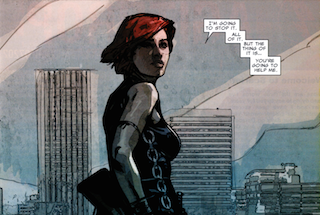 This focus on Scarlet is what makes the story work as well as it does and what prevents it from being pedantic. We want to know more about Scarlet, a young woman who comes of age in the worst way possible: Through the ordeal of a horrific confrontation with a police officer. And yet, we are not sure how much to like her, because when this violence enters her life, she decides that the best reaction is to protest through killing police officers.
This focus on Scarlet is what makes the story work as well as it does and what prevents it from being pedantic. We want to know more about Scarlet, a young woman who comes of age in the worst way possible: Through the ordeal of a horrific confrontation with a police officer. And yet, we are not sure how much to like her, because when this violence enters her life, she decides that the best reaction is to protest through killing police officers.
As a fan of crime fiction, I am particularly appreciative of the way Bendis blends two of my favorite sub-genres of crime fiction: The Police Procedural and Noir. These also are two of Bendis’s favorite types because in his creator-owned books, he has primarily written about either one or the other. In fact, I think maybe all his creator-owned work falls into one of those two categories.
The Police Procedural, like the first half of Law and Order (the Order part), usually either focuses on one detective or considers the police squad itself a character. Noir fiction focuses on the other side, the criminal’s side. In noir, we are often led to root for the criminal, even when it disturbs us, which it often does because the criminal is frequently a 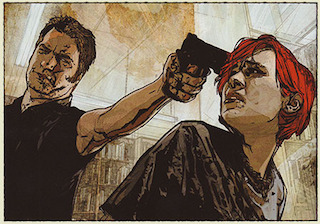 murderer, as in Scarlet. In a Police Procedural we are led to side with the cops, and because this book uses that sub-genre, too, by the end of volume two, we begin to empathize with some of the police officers. Bendis brilliantly blends these two sub-genres together, but he does so for a reason — to get us to think about both sides of this issue.
murderer, as in Scarlet. In a Police Procedural we are led to side with the cops, and because this book uses that sub-genre, too, by the end of volume two, we begin to empathize with some of the police officers. Bendis brilliantly blends these two sub-genres together, but he does so for a reason — to get us to think about both sides of this issue.
In terms of the plot, I cannot say much without spoiling the book because of the design of the narrative: It starts with a full-page image of Scarlet choking a man to death in an alley. It takes several pages before we even find out who this man is and what his relationship to Scarlet is. The answer to that question, of course, raises even more. And we are forced to wait for answers to the new questions, because Bendis then gives us a flashback as Scarlet tells us the events that led up to her being in this alley. Bendis will continue to use these character-narrated flashbacks throughout both volumes, and sometimes it happens at odd moments, sometimes right in the middle of an intense scene. However, these jumps and pauses in time are not confusing at all because Bendis handles this narrative technique with expertise.
When I write that Scarlet “tells us the events,” I am referring to one of the most noticeable, effective, and emotionally charged literary techniques used in the book: Scarlet, and eventually other characters, frequently break the fourth wall 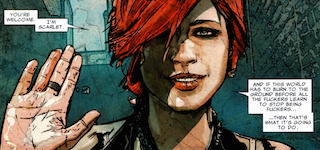 and speak directly to us as readers, which is visually represented by a square rather than a round speech bubble. It’s very unsettling in a good way, because it brings us into the story and asks us to think about the ethical implications of the characters’ actions, actions that are quite disturbing, to put it mildly.
and speak directly to us as readers, which is visually represented by a square rather than a round speech bubble. It’s very unsettling in a good way, because it brings us into the story and asks us to think about the ethical implications of the characters’ actions, actions that are quite disturbing, to put it mildly.
In the second volume, as Scarlet’s entourage grows, more and more characters look us straight in the eye and address us, explaining to us, pleading with us to understand. While they talk, the action goes on around them without any other characters being able to notice this break in the fourth wall.
 The artist, Alex Maleev, is effective at depicting these moments: Somehow, this impossible scenario works when it happens in the middle of a scene. His art throughout the book is excellent; noir-ish with muted colors. The color red, however, jumps out at us on every page, from almost every panel it seems — a red that alludes not merely to the main character and her red hair (which is used as a plot device several times), but also to the amount of blood being shed.
The artist, Alex Maleev, is effective at depicting these moments: Somehow, this impossible scenario works when it happens in the middle of a scene. His art throughout the book is excellent; noir-ish with muted colors. The color red, however, jumps out at us on every page, from almost every panel it seems — a red that alludes not merely to the main character and her red hair (which is used as a plot device several times), but also to the amount of blood being shed.
Obviously, given the Black Lives Matter movement, this story is of incredible relevance to us now, and yet Bendis gives us a little distance because he seems to take race out of the equation right from the start: Scarlet and her boyfriend are both white characters and are obviously not targeted because of racism. Bendis just sidesteps the issue.
On the other hand, maybe he wasn’t intentionally sidestepping the issue. In 2010 when he started writing Scarlet, maybe it didn’t seem like the unavoidable issue it is now. If he were starting the book now, I think he might have addressed the racial issue right from the start. In 2010, the Black Lives Matter Movement was still three years off and had not yet helped bring this concern into greater light for the non-black public (obviously, the black community — and many others who were paying attention — knew that there were an alarming number of police officers escaping punishment after murdering innocent African-Americans).
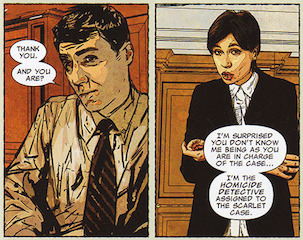 As Bendis wrote the series, I think this issue became more important to him (as it has for many of us). In the second arc, he gives us the backstories of several characters. One of these characters is a black woman whose life has been horribly impacted because of a police officer killing a family member. We are shown her witnessing this event in a flashback. I think Bendis was right to add this character’s story to Scarlet; by doing so, he makes it clear that Scarlet encompasses the events that we keep witnessing via phone and police cameras in our daily lives, though his story does not exclude other reasons for anger and protest.
As Bendis wrote the series, I think this issue became more important to him (as it has for many of us). In the second arc, he gives us the backstories of several characters. One of these characters is a black woman whose life has been horribly impacted because of a police officer killing a family member. We are shown her witnessing this event in a flashback. I think Bendis was right to add this character’s story to Scarlet; by doing so, he makes it clear that Scarlet encompasses the events that we keep witnessing via phone and police cameras in our daily lives, though his story does not exclude other reasons for anger and protest.
Bendis stretches his critique of society even more when he includes a prior member of the military and his backstory. And in the second volume, a secondary character begins to share the narrative spotlight with Scarlet: We meet a female police officer as she is beginning to get in touch with her suppressed anger after years of dealing with the misogyny within the police force. She tells us her past in another flashback, but most of her story takes place in the present along with Scarlet’s story. While Scarlet is out in the world avoiding the police, this female police officer is at the center of the other major setting of the book: The police station. The story alternates between Police Procedural and Noir, between female cop’s narrative with the police, a group of men, and Scarlet’s story, which involves those who have been hurt and damaged in a dangerous world.
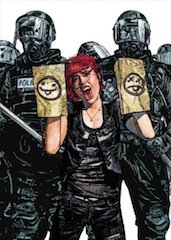 What is Scarlet’s mission? To change the world, to protest, and to do so through violence. She comes to the conclusion that it is not only permissible for her to kill police officers, but also an obligation. Am I praising and asking you to read a book that endorses the killing of police officers? I do not think so, or would not be recommending it. I think Bendis is using his fiction to show us what the most extreme reaction to our current situation would look like. That reaction would return violence for violence.
What is Scarlet’s mission? To change the world, to protest, and to do so through violence. She comes to the conclusion that it is not only permissible for her to kill police officers, but also an obligation. Am I praising and asking you to read a book that endorses the killing of police officers? I do not think so, or would not be recommending it. I think Bendis is using his fiction to show us what the most extreme reaction to our current situation would look like. That reaction would return violence for violence.
In thinking about ethical vision of this book, we should not confuse the main character with her creator: Scarlet constantly talks to us and explains to us, and she asks us to believe in her and to believe that what she is doing is morally right and morally necessary — that perhaps it’s morally wrong not to protest through violent action.
The author, I am sure, is not inviting us to agree with Scarlet. He’s asking us to think about her ethical stand. Bendis is obviously as upset as most of us are about the death of innocents at the hands of police officers who are not held accountable for their actions. So, I think he’s getting us to think about two extreme reactions: Doing nothing versus devoting one’s life to protesting through killing police officers. I believe Bendis is asking us to think about where we stand. I don’t think he’s telling us where to stand, though I think he is telling us to take a stand at the very least.
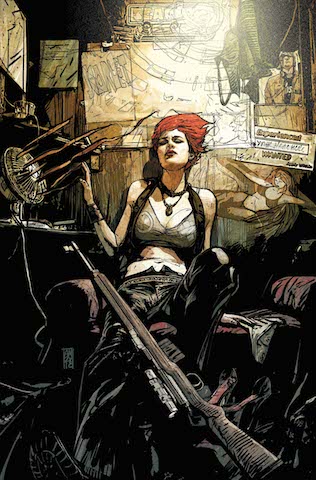 And that’s why I think this book is so great: It’s not simplistic, and it doesn’t give us any easy answers. It demand of us that we question ourselves, that we think carefully about how we react to our current situation that the Black Lives Matters movement is asking us to think about. Yes, we should be angry, Bendis makes clear, but what should we do with that anger? How should we channel it? How should we protest in ways that will have real influence and yet still fall within an ethically acceptable range of actions (unlike Scarlet)?
And that’s why I think this book is so great: It’s not simplistic, and it doesn’t give us any easy answers. It demand of us that we question ourselves, that we think carefully about how we react to our current situation that the Black Lives Matters movement is asking us to think about. Yes, we should be angry, Bendis makes clear, but what should we do with that anger? How should we channel it? How should we protest in ways that will have real influence and yet still fall within an ethically acceptable range of actions (unlike Scarlet)?
If you are like me, you might not want to think about this concern when you read fiction, since it pervades our real life enough and might be the very thoughts you want to escape by reading fiction in the first place. But, just as much as we need fiction that is designed primarily for escape, we also need fiction that is focused primarily on real-world concerns. Scarlet is beautifully written and illustrated both to take us inside a story that will upset us and to give us enough distance to be able to think about it. And in the end, Bendis uses Scarlet not to tell us how to act, but to tell us that we should act and that we should think carefully about what is the most effective, ethical response to these problems.



Brad, a thoughtful and in-depth review. I don’t know if I want to read this or not. I will have to think about it.
I hope you will give it a chance. He made it possible for me to read about a very difficult topic. I was surprised. If someone had told me about the topic for this book NOW, I would not have wanted to read it, to be honest, so I’m glad I started it years ago. But, I hope my review makes a convincing case for why you should let it override the initial response to not want to read a comic book like this. Part of what is bizarre is how likable Scarlet is. It’s this harsh noir comic presented as teen girl coming of age. I guess I should have said that in my review; it makes clearer the strange contradiction in moods that come across in the book.
Definitely sounds like a series worth reading and very topical indeed. I’ve only observed the situation in the US from far away, but it makes me upset and at a loss as to what can be done to improve things (well, making sure Trump doesn’t become President is a top priority). As you said so well:
“If you are like me, you might not want to think about this concern when you read fiction, since it pervades our real life enough and might be the very thoughts you want to escape by reading fiction in the first place. But, just as much as we need fiction that is designed primarily for escape, we also need fiction that is focused primarily on real-world concerns.”
The art is amazing.